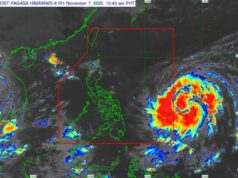Gov’t sets guidelines for moderate lifting of quarantine rules
THE national government released on Tuesday the guidelines for the general community quarantine (GCQ), wherein more businesses will be allowed to reopen and public transportation can resume, taking effect May 1 in many areas across the country. The GCQ will be adopted in localities considered as having low to moderate risk for the coronavirus disease 2019 (COVID-19). The areas that will remain under the more stringent enhanced community quarantine until May 15 are: National Capital Region; Central Luzon Region except Aurora province; Region 4-A composed of the provinces of Cavite, Laguna, Batangas, Rizal, and Quezon (CALABARZON); Pangasinan province; Benguet province; Baguio City; Iloilo province; Cebu province; Cebu City; and Davao City. Palace Spokesperson Harry L. Roque, in a briefing on Tuesday, said restrictions in the GCQ areas could be further eased after May 15. The guidelines contain minimum health safety requirements such as continued observance of physical distancing. It also outlines the industries or sectors that will be allowed to resume operations. These include shopping malls and the non-leisure shops located there; barber shops, salons, and spas; transportation retail and repair; Build, Build, Build projects; and forestry and logging, among others.
VIOLATORS
Meanwhile, violators of quarantine rules should be disqualified from receiving government aid, the House Peace and Order Cluster recommended. “This is a strong deterrent. Violators should be disqualified already from receiving further government aid such as the cash assistance program,” Masbate Rep. Narciso R. Bravo Jr., committee chair, said during the House Defeat COVID-19 hearing on Tuesday. The panel also recommended the continued imposition of curfew even in areas under GCQ. — Gillian M. Cortez and Genshen L. Espedido
DoF says bulk of COVID-19 expenditures went to emergency subsidies
MAJORITY of the P352 billion spent so far for the coronavirus disease 2019 (COVID-19) response, worth P258 billion or 73% of the total, were used to fund emergency subsidies for poor families and other vulnerable sectors, according to the Department of Finance (DoF). Citing data from the Department of Budget and Managemage (DBM), DoF reported that P200.42 billion went to the Social Amelioration Program (SAP) and other relief measures, P51 billion for the wage subsidy program for employees of small businesses, and P6.435 billion for the Labor department’s programs for workers affected by the lockdown. The P94 billion balance was used to boost the Department of Health’s capacity to respond to the outbreak and other relief initiatives. Finance Secretary Carlos G. Dominguez said the government will keep its budget for projects under the “Build, Build. Build” program as these will create jobs and boost economic activity once the outbreak is contained. The DBM said the P352 billion released was sourced from the P397.513 billion worth of capital outlays considered as “for later release” under the different departments. In another development, the Palace announced it will give a P20 million reward to those who will develop a respirator that can be manufactured locally. The P20 million bounty comes after President Rodrigo R. Duterte announced he will give a P50 million reward to anyone who can develop a vaccine for COVID-19. — Beatrice M. Laforga and Gillian M. Cortez
Bill creating Center for Disease Control filed in Senate
A LAW establishing the Philippine’s Center for Disease Control (CDC) has been proposed in the Senate. Senator Grace S. Poe-Llamanzares filed Senate Bill No. 1450, the “Pandemic Preparedness and Response Act,” to set up a more proactive response to health crisis such as the current coronavirus disease 2019 (COVID-19) outbreak. “We need to catalyze support for a proactive and efficient health system with increased capacities to prevent and control the spread of new or recurring infectious diseases,” Ms. Llamanzares said in a statement Tuesday. Under the bill, the CDC will spearhead the creation of the National Strategy for Public Health Emergencies. It will also absorb agencies under the Department of Health, including the Disease Prevention and Control Bureau, Epidemiology Bureau, Health Emergency Management, Bureau of Quarantine and the Research Institute for Tropical Medicine. The proposed law also includes the creation of the Medical Reserves Corp, consisting of volunteer health professionals who will be called to duty during a health crisis. Senator Pia S. Cayetano, for her part, pushed for the passage of Senate Bill No. 63, the “Build, Build, Build for Health” bill, which will bring focus on sustainable health infrastructure over the next five years. “It is a good time to redesign our country’s health care facilities, to keep our health workers safe and to address the fear and the reality that these very facilities that are there to provide health remedies are also hot spots for the spread of viruses and germs,” she said in a statement. — Charmaine A. Tadalan
Courts in ECQ areas to remain suspended

THE Supreme Courts extended until May 15 the temporary closure of courts in areas identified as high-risk by the national government and will remain under enhanced community quarantine (ECQ). Under Administrative Circular No. 35-2020, all courts in areas under ECQ shall be closed and may be reached only through hotline numbers and online. “The on-line filing of criminal complaints and informations, posting of bail, and submission of other urgent pleadings shall continue to be in effect until 15 May 2020 in the ECQ areas,” the circular read. Another circular, No. 36-2020, orders courts in areas under the less stringent general community quarantine to reopen on May 4, but only with skeleton staff that will act on urgent matters. Judges and court personnel who are at least 59 years and those with underlying medical conditions may report to court on urgent matters only. Lawyers of the same age may attend hearings except those with illnesses. — Vann Marlo M. Villegas



